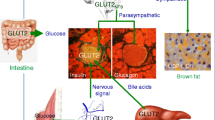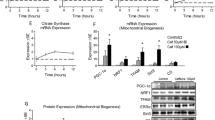Abstract
The effects of orexins, which are also named hypocretins, on cAMP formation were examined in primary cultures of rat astrocytes. Orexin A, an agonist of OX1 and OX2 receptors, stimulated cAMP production with an EC50 value of 0.68 μM and potentiated the forskolin-induced increase in the nucleotide synthesis. [Ala11-D-Leu15]orexin B, an agonist of OX2 receptors, was inactive. The effects of orexin A were antagonized by SB 408124, a selective blocker of OX1 receptors, but were not affected by TCS OX2 29, a selective antagonist of OX2 receptors. We hypothesized that the activation of OX1 receptors stimulated cAMP synthesis in primary rat astrocyte cultures.
Similar content being viewed by others
Abbreviations
- cAMP:
-
cyclic 3’,5’-adenosine monophosphate
- GFAP:
-
glial fibrillary acidic protein
- IBMX:
-
3-isobutyl-l-methylxanthine
- OX1:
-
orexin type 1 receptor
- OX2:
-
orexin type 2 receptor
- SB 408124:
-
N-(6,8-difluoro-2-methyl-4-quinolinyl)-N’-[4-dimethylamino)phenyl]urea
- TCS OX2 29:
-
(2S)-1-(3,4-dihydro-6,7-dimethoxy-2(1H)-isoquinolinyl)-3,3-di-methyl-2-[(4-pyridinylmethyl)amino]-1-butanone hydrochloride
References
Ammoun S, Holmqvist T, Shariatmadari R, Oonk HB, Detheux M, Parmentier M, Åkerman KE, Kukkonen JP: Distinct recognition of OX1 and OX2 receptors by orexin peptides. J Pharmacol Exp Ther, 2003, 305, 507–514.
Asahi S, Egashira S-I, Matsuda M, Iwaasa H, Kanatani A, Ohkubo M, Ihara M, Morishima H: Development of an orexin-2 receptor selective agonist, [Ala11, D-Leu15]orexin-B. Bioorg Med Chem Lett, 2003, 13, 111–113.
Gorojankina T, Grébert D, Salesse R, Tanfin Z, Caillol M: Study of orexin signal transduction pathways in rat olfactory mucosa and in olfactory sensory neurons-derived cell line Odora: Multiple orexin signalling pathways. Reg Peptides, 2007, 141, 73–85.
Heinonen MV, Purhonen AK, Mäkelä KA, Herzig KH: Functions of orexins in peripheral tissues. Acta Physiol (Oxford), 2008, 192, 471–485.
Hertz L, Juurlink BHJ, Szuchet S: Cell cultures. In: Handbook of Neurochemistry. Ed. Lajtha A, Plenum Press, New York, 1985, vol. 8, 603–661.
Hirose M, Egashira S, Goto Y, Hashihayata T, Ohtake N, Iwaasa H, Hata M et al.: N-acyl 6,7-dimethoxy-1,2,3,4-tetrahydroisoquinoline: the first orexin-2 receptor selective non-peptidic antagonist. Bioorg Med Chem Lett, 2003, 13, 4497–4499.
Holmqvist T, Johansson L, Ostman M, Ammoun S, Åkerman KE, Kukkonen JP: OX1 orexin receptors couple to adenylyl cyclase regulation via multiple mechanisms. J Biol Chem, 2005, 280, 6570–6579.
Jóźwiak-Bębenista M, Dejda A, Nowak JZ: Effects of PACAP, VIP and related peptides on cAMP formation in rat neuronal and astrocyte cultures and cerebral cortical slices. Pharmacol Rep, 2007, 59, 414–420.
Kagerer SM, Jöhren O: Interaction of orexins/hypocretins with adrenocortical functions. Acta Physiol (Oxford), 2010, 198, 361–371.
Kamenetsky M, Middelhaufe S., Bank EM, Levin LR, Buck J, Steegborn C: Molecular details on cAMP generation in mammalian cells: A tale of two systems. J Mol Biol, 2006, 362, 623–639
Kukkonen JP, Holmqvist T, Ammoun S, Åkerman KE: Functions of the orexinergic/hypocretinergic system. Am J Physiol Cell Physiol, 2002, 283, C1567–1591.
Magga J, Bart G, Oker-Blom C, Kukkonen JP, Åkerman KE, Näsman J: Agonist potency differentiates G protein activation and Ca2+ signalling by the orexin receptor type 1. Biochem Pharmacol, 2006, 71, 827–836.
Matsuki T, Sakurai T: Orexins and orexin receptors: from molecules to integrative physiology. Results Probl Cell Differ, 2008, 46, 27–55.
Porter RA, Chan WN, Coulton S, Johns A, Hadley MS, Widdowson K, Jerman JC et al.: 1,3-Biarylureas as selective non-peptide antagonists of the orexin-1 receptor. Bioorg Med Chem Lett, 2001, 11, 1907–1910.
Ramanjaneya M, Conner AC, Chen J, Stanfield PR, Randeva HS: Orexins stimulate steroidogenic acute regulatory protein expression through multiple signaling pathways in human adrenal H295R cells. Endocrinology, 2008, 149, 4106–4115.
Rouet-Benzineb P, Rouyer-Fessard C, Jarry A, Avondo V, Pouzet C, Yanagisawa M, Laboisse C et al.: Orexins acting at native OX1 receptor in colon cancer and neuro-blastoma cells or at recombinant OX1 receptor suppress cell growth by inducing apoptosis. J Biol Chem, 2004, 279, 45875–4586.
Sadana R, Dessauer CW: Physiological roles for G protein-regulated adenylyl cyclase isoforms: insights from knockout and overexpression studies. Neurosignals, 2009, 17, 5–22.
Shimizu H, Daly JW, Creveling CR: A radioisotopic method for measuring the formation of adenosine 3’,5’-monophosphate in incubated slices of brain. J Neurochem, 1969, 16, 1609–1619.
Tang J, Chen J, Ramanjaneya M, Punn A, Conner AC, Randeva HS: The signaling profile of recombinant human orexin-2 receptor. Cell Sign, 2008, 20, 1651–1661.
Urbańska A, Sokołowska P, Woldan-Tambor A, Biegańska K, Brix B, Jöhren O, Namiecińska M, Zawilska JB: Orexins/hypocretins acting at Gi protein-coupled OX2 receptors inhibit cyclic AMP synthesis in the primary neuronal cultures. J Mol Neurosci, 2011, doi: 10.1007/s12031-011-9526-2.
Zhu Y, Miwa Y, Yamanaka A, Yada T, Shibahara M, Abe Y, Samurai T, Goto K: Orexin receptor type-1 couples exclusively to pertussis toxin-insensitive G-proteins, while orexin receptor type-2 couples to both pertussis toxin-sensitive and -insensitive G-proteins. J Pharmacol Sci, 2003, 92, 259–266.
Author information
Authors and Affiliations
Corresponding author
Rights and permissions
About this article
Cite this article
Woldan-Tambor, A., Biegańska, K., Wiktorowska-Owczarek, A. et al. Activation of orexin/hypocretin type 1 receptors stimulates cAMP synthesis in primary cultures of rat astrocytes. Pharmacol. Rep 63, 717–723 (2011). https://doi.org/10.1016/S1734-1140(11)70583-7
Received:
Revised:
Accepted:
Published:
Issue Date:
DOI: https://doi.org/10.1016/S1734-1140(11)70583-7




